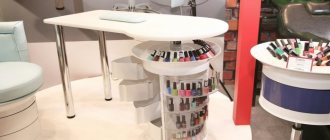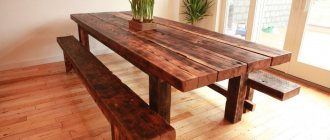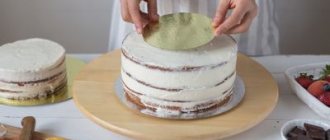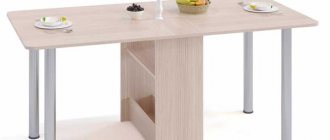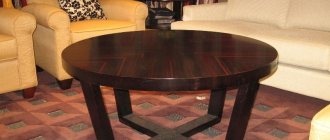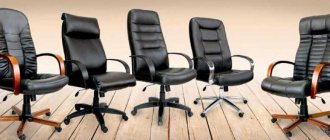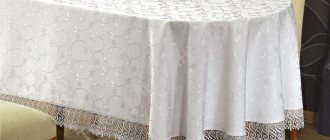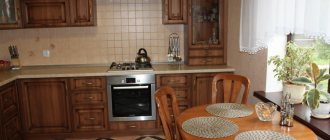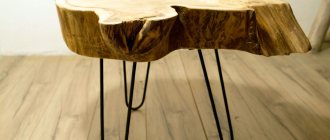For apartments with insufficient free space, the optimal solution would be a folding table mounted to the wall. Its main advantage is its ability to take both vertical and horizontal positions.
The design is a tabletop equipped with a special mechanism. Thanks to the canopies, it is attached to the wall, and the retractable leg makes it stable. This model is usually made in the shape of a semicircle or rectangle.
Features of folding tables
For families with average income, it is unrealistic to purchase a spacious home with a kitchen of more than twenty square meters. In this regard, they have to go to all sorts of sophistication, coming up with furnishing options for a small space.
Folding tables provide an opportunity to save free space not only in residential premises and on balconies, but also in garages. In addition, they fit perfectly into the interior and can be manufactured in two versions. The first is made in the form of a narrow strip, and the second is an object that merges with the wall.
When unfolded, the models have different sizes. They can be a table for one or two people or a full table that can accommodate several people at once.
Device
The working surface of the folding versions is mounted to the wall using a hinged mount with one or more hinges. This makes it possible to easily fold or unfold the structure.
The table top has a support that can either fold or move apart, resting against the wall and providing an additional point of support. As the table top takes on a horizontal position, it rises up and the leg moves to the side. This design solution provides balance to the folding table.
There are models in which the legs are not connected to the main system, but are inserted as needed. Typically, such a separate support element is fixed in a hole located at the bottom of the tabletop, which prevents unwanted falls as a result of unsuccessful movements.
At the same time, there are options with a support that is pre-attached to the bottom of the table cover and unfolds simultaneously with it. A support is mounted to one side of this model, and hinged fasteners are mounted to the other.
Certain types of folding surfaces unfold and fold according to the accordion principle, that is, in one movement. Such structures unfold in one moment, which is an important advantage.
Of great interest are the types of tables with a flat support, made in the form of a triangle and attached to the wall under the tabletop. Models on brackets installed without hinges and made of metal or stainless steel are considered no less successful.
Advantages
The folding system can be placed in any part of the room. To do this, it is important to decide on the type of model and materials for its implementation.
This solution has a number of advantages:
- Compactness and ease of use, which are considered one of the main attractive qualities.
- The ability to blend perfectly with the overall interior of the room.
- Versatility, allowing the structure to be used not only as a table, but also for other household needs, for example, for ironing clothes.
- Simplicity and reliability in operation.
- Easy installation.
- Reasonable price.
Flaws
The disadvantage of folding options is their small size. The structure attached to the wall is not capable of accommodating a large number of people. As a rule, no more than seven people can sit behind such a model.
Types of fastenings
You understand that the design of a do-it-yourself folding table can vary significantly from case to case. The most practical option would be a simple folding table, the tabletop of which will rise when needed and lower when there is no need for a table. The most important thing in this is what the implementation of the locking mechanism will be.
- Do-it-yourself shoe racks: a review of the best ideas and a step-by-step description of how to build a shoe rack (85 photos and videos)
Do-it-yourself bag chair - a detailed master class on how to sew a properly comfortable chair (75 photos)
DIY chest - how to make a beautiful and stylish craft from a box, paper and wood (80 photos)
If we make a kitchen folding table with our own hands, then we need to take into account the size of the room. Most likely, if you are considering this option, your kitchen is quite small.
In this case, the leg can be hidden under the tabletop, while the latter will have a semicircular shape. Everything so that the corners do not interfere with passing by.
This DIY wall-mounted folding table will have a number of design features. Let's start with the fact that the tabletop itself will not be attached directly to the wall, then you will understand why.
First, we must take care of the mounting of the leg, which will be placed on the wall, and the base of the tabletop, which will be located a little higher.
We will make the leg triangular so that the support is maximum, but at the same time it does not interfere with the legs. The triangle will be rectangular so that when opened, its base and tabletop will have tight contact with its sides.
In this case, the tabletop will not be mounted on the wall itself, but on an additional base, as mentioned earlier. This is necessary in order to create a gap between the wall and the tabletop - the closed leg with its cooling will be hidden in it.
DIY bread box - step-by-step master class on making and tips on how to decorate a wooden model (105 photos + video)DIY high chair - interesting drawings and projects on how to make a comfortable and functional high chair (120 photo ideas)
DIY built-in wardrobe: 115 photos of original ideas and video tips for building built-in wardrobe models
Types of folding tables by shape
Configuration and design are considered one of the main criteria that guides the selection of a suitable option.
Despite the fact that folding tables can have a wide variety of shapes, the following versions are considered the most popular:
- Square, reminiscent in appearance of a traditional table. Such models differ from classic furniture only in the absence of legs. They will be the ideal solution for a family of three.
- Rectangular, which is the most popular due to its comfort and spaciousness. This design has a larger number of seats than options with other configurations.
- Round, which is an unusual idea for a folding table and looks great against the background of the overall design of the room.
- Semicircular, advantageous in compactness, but not characterized by optimal capacity. This solution is most suitable for a loggia.
Comments: 17
Art Atelier
In your case, it is better to rest the tabletop on the floor (it is generally undesirable to hang and sit on them). Usually, if the structure or installation conditions are complex, then those people who will supply and install the stone product themselves go to the site and calculate the weight of the structure (how thick will it be - with a glued side? How exactly is the sink installed, etc. ) then they develop a welded structure for themselves and issue an order for the installation of embedded parts / Or maybe they just sacred an L-shaped frame, where the vertical part will be in the plane of the wall. Probably no one will answer in absentia.
- Like | 3
- Save
- Like
- Save
ryllova
I just don’t want what you sent. That's why I turned to the experts
- Like
- Save
Dmitry Evgenievich
Just attach the tabletop to the wall, in the corner. To do this, even at the stage of wall construction, it was necessary to provide fastening elements. Otherwise, you won’t be able to do what you want.
- Like
- Save
ryllova
It's not too late for us to make these fasteners in the wall. It was just laid out to us. Yes, we planned to mount it in the wall and on the corner, where it would be adjacent to the cabinet wall. I'm worried about the other corner that will hang up, near the bathtub. What fasteners do you recommend? It seems to me that the letter G is a little dangerous, the edge will be hanging
- Like
- Save
SOS REPAIR
- Like
- Save
ryllova
Thank you very much for the recommendations. Some are just a mystery to me: “do it on the floor, but make the very bottom mirrored and a little ruined.” I can’t even imagine what it is and how it is :)
Do you have an example?
And about the lighter analogue. What did you mean? What could be lighter and more like a stone?
- Likes: 1
- Save
Galina
- Like
- Save
SOS REPAIR
- Like
- Save
- Like
- Save
ryllova
Thanks for the advice. But in your example, the wall in which the frame is embedded is most likely concrete. In my case, both the side wall and the back are made of tongue-and-groove slabs :(
- Like
- Save
Evgeny S
In 1 comment they wrote to you the best solution to your problem, contact the countertop manufacturer so that they issue a technical specification for the installation of embedded parts. Or so that they themselves prepare a welded structure, for example, under a tabletop.
- Likes: 1
- Save
solid wood doors
In order for the tabletop to hang in the air, a frame is made under it (chipboard, wood, if the thin option is only iron or stainless steel if the budget allows and an open design is required)
The frame is attached to the wall with anchors, screws, or better yet, a chemical anchor.
It is important that the surface is reinforced with a sheet of chipboard or plywood (they mainly make air - they save money).
The stone is very afraid of impacts when there is air under it, the overlaps on the sides are also not large (up to 30mm with a thickness of 30mm) if more, it is reinforcement during the manufacture of the tabletop.
Fastening to the frame - on a 50*50mm mesh made of silicone (holds firmly and can be easily cut if necessary.
Related article: Rear panels for walls in the interior
It is better to polish the lower edge (protruding beyond the frame) during production - better aesthetics.
Connecting to the wall - silicone with a continuous 1mm seam on the slab (remove excess immediately) - under no circumstances should we make a silicone side - it turns black over time.
We use only expensive branded silicone.
In this way we attached very thick tabletops to thin walls (they stand very well)
The sink is attached to a groove on the frame and the countertop is placed on top - all connections are silicone.
It’s important - make the height higher than the standard - the splashes don’t fly away so much and hands are washed directly in the sink and not for days - but the children will still use the high chair while they are small.
Types of tables by type of design
Even a small table can take up a significant part of the usable space in the room. Recently, in order to save it, the free part of the wall to which folding structures are attached is increasingly being used.
There are many types of folding systems, differing in configuration and size. In addition, each of the models is characterized by its design and purpose.
Transformer
This model is the most common option due to its functionality.
There are the following types of transforming tables:
- wall;
- wall-mounted
In most cases, this type is used in the kitchen, as it has several zones. It is easy to use and can be turned into either a compact option that does not take up much space, or a place for eating.
The transformer, which can be adjusted, has certain functions that are not available in a conventional folding model. For small rooms, specimens are made without legs, designed for vertical mounting on the wall. Similar tables with one leg are also available, but this version is less stable.
Folding
This model is considered universal, due to the fact that it can be attached to any straight surface, for example, to a wall or cabinet. Due to the stability of the folding table to heavy loads, it can act as a work table or school desk.
These structures have different sizes, which are selected in accordance with their location and purpose. It should be remembered that large and heavy tabletops require supports such as several posts or spacers.
For very small rooms, the optimal solution would be to arrange a closet with a folding table. Despite the fact that the model is not able to support very bulky and heavy objects, it is quite possible to place a laptop or writing utensils on it to complete tasks. Such a workplace will take up a minimum of usable space. Similar options can be installed in the hallway and kitchen.
Experts recommend choosing models equipped with drawers and shelves if overload is expected during use. For example, the kitchen table is constantly lined with dishes, and the work or school model is always lined with books. All these items can be placed in storage areas. For the bedroom, the best option would be a folding design with a mirror that opens like an accordion.
The fastenings of the folding surfaces are subject to excessive loads. In this regard, during installation, you should use high-quality fasteners. You should also not make mistakes that could later lead to a system crash with subsequent damage to the wall finish.
Mobile folding
The advantage of this model is that it is not only mobile, but also movable. The fastening, made in the form of rails, allows the tabletop to move along the wall on which it is fixed.
This solution is considered the most suitable for an unusual layout or kitchen. The ideal location for a mobile folding table under the kitchen unit. Taking up virtually no space, it forms a single unit with the wall to which it is attached.
Typically, such a design is complemented by legs, which give it stability during operation.
Reclining bar counter
Models of this type will be appropriate for installation in a kitchen or dining room. Designers often use this option as a technique for zoning space in a modern interior.
The design is a tabletop with a wall-mounted mount. Its shape is quite narrow and elongated, which allows it to fit even into very small rooms. There are varieties that are attached on one side to the wall and the other to the floor.
Bar counter options are distinguished by their original design, which often uses glass or mirror panels. These elements are built into the wood and give the room a luxurious look. An excellent solution would be to install similar structures in long kitchens. As a rule, they are mounted at a respectable height and are therefore complemented by chairs with long legs.
Suspension
Hanging tables are relevant for very small apartments, the area of which does not allow for the arrangement of a full-fledged place for any activities. Comfortable and multifunctional furniture designed for these purposes will become an overload for a limited space. Therefore, this option will allow you to get out of this difficult situation. Despite its small size, it is easy to use and stylish in appearance.
The hanging table consists of a plate in a horizontal position and two hangers. Each of the latter elements is equipped with fastening points, one of which connects the suspension to the plate, and the other to the ceiling.
These models are not recommended for installation in rooms where there are small children and pets. The fact is that when pushed, the contents of the table can fall and cause harm to them, which is a disadvantage of the hanging option.
Folding
This design also allows for a folding system and is usually installed on balconies or small kitchens. In its structure, the folding table has some similarities with transformers. However, it differs from them in its simple design and functionality - due to the lack of additional features.
The main difference between the folding version and other types of folding tables is the inability of the tabletop to fold back completely. Due to the fact that one of its parts remains in the same position, it is impossible to bring the model into a vertical position and place it flush against the wall.
When folded, the table resembles a small cabinet in which it is convenient to store all kinds of kitchen utensils. For meals, it easily unfolds and accommodates several people at once. Which is not at all necessary to do during its operation by one person.
When is additional fixation necessary?
The countertop in the kitchen sometimes takes on very significant loads. When slicing food, it only requires sufficient area and a flat surface. But often we also load the table with small household appliances. Microwave, oven, portable dishwasher, coffee maker, mini-bar - all these items in the kitchen often “settle” on the table, and here you will need to secure it well.
Related article: How to calculate the amount of paint for walls
You should not discount the neat appearance of the kitchen - an unfixed countertop can sometimes move, forming a noticeable gap in contact with the wall. Not only does this spoil the picture a little, but also food particles will accumulate there. It is useless to attach a decorative plinth to such a moving surface. And if the design of the set is such that the tabletop has freely hanging ends, instead of a reliable working surface you become the owner of an analogue of a children's swing. So it’s better to attach the top plate even on the cabinets to the wall so that it doesn’t “play.”
Sometimes the only way to increase the functionality of a small kitchen is to make additional surfaces with your own hands where you can place equipment or process food. You cannot provide support for such tabletops from below, but fixing them on the wall is quite possible. And of course, you can’t do without this if there is built-in appliances hidden under the work surface - a refrigerator or a washing machine.
What materials are they made from?
Furniture pieces serve as interior decoration, create comfort in the room and perform certain functions. Do-it-yourself designs can significantly save material resources. For example, the cost of purchasing a finished table will exceed by 70% the amount that will be needed to purchase material for independent production.
After the shape of the future product and its dimensions are outlined, calculations are made of the amount of required materials. When choosing them, it is important to consider the strength of the table, which directly depends on the density of the material. It is also worth taking care of the appearance of the structure, which should match the design of the room where it will be located.
Chipboard, MDF
You can make a tabletop yourself from different materials, including sheet versions. Their main advantage is expressed in integrity. A cover is cut out using a jigsaw, which can be used immediately by covering the cut edges with a special tape for finishing furniture.
A table made from any type of sheet material is relatively light in weight. This allows you to fold back its surface without any effort. It is recommended to select chipboard with a high-quality coating; for example, you can use sheets from old cabinets. The disadvantage of this material is toxicity, and MDF is susceptible to fire.
Wood
Reclining structures, among other materials, can be made of wood.
The natural wood option has the following advantages:
- environmental Safety;
- exquisite appearance;
- strength;
- resistance to sunlight;
- easy maintenance during operation;
- long service life.
The weaknesses of wooden models include sensitivity to high levels of humidity. Despite the fact that such material has a high cost, the modern market allows for the possibility of choosing at affordable prices.
This also applies to finished products.
When making a table yourself, you must adhere to two basic rules:
- Make the right choice of wood type.
- Carry out work using appropriate devices - due to the complex specifics of manufacturing.
Using a jigsaw or a hand router, a folding table can be made without significant time and material costs.
Glass
In addition to natural wood and sheet material, the tabletop can be constructed from tempered glass, which is distinguished by its solid thickness. This material is not used very often and is not suitable for work at home.
When choosing a material, it is necessary to take into account the place in the room where the table will be installed in the future. Made of glass and wood, it will not be able to harmonize with all pieces of furniture. In this regard, it is recommended to mount this model separately from them.
In addition to glass, optimal materials would be:
- plywood;
- tree:
- chipboard;
- MDF.
Countertops can have a wide variety of configurations, but most often they come in the form of a square or rectangle. The shape is set during the manufacturing process using a jigsaw, and the edges are processed with a grinding machine.
Plastic
Nowadays, plastic is becoming more and more in demand as a material for furniture and household items. The quality of the product is affected by the composition and structure of the substances used in the formation of the plastic base.
Among the variety of materials of this type, several basic ones that are popular in production stand out:
- Polyvinyl chloride (PVC) has the most affordable price. At the same time, a tabletop made of this type of plastic will not be durable.
- Polymethyl methacrylate is a durable option and is used to make quality furniture pieces. Its advantage lies in its ability to be perfectly combined with any type of material.
When choosing a reclining table, as a rule, its appearance and ease of use and maintenance are taken into account. In addition, environmental safety is of great importance, especially for varieties associated with eating and preparing food.
Even a small table takes up a significant part of the room. In order to organize space, people have long begun to use the free surface of walls, cabinets or shelving. Over time, such models have undergone both structural transformations and changes in style. These days, the market offers a wide range of tables for various purposes and for any type of room.
A surface that can recline will become appropriate not only in living rooms, but also in the hallway with a bathroom. With its help, you can arrange a work area or recreation area anywhere. Often, folding tabletops are used as an additional useful surface for a certain period of time. For example, for placing boxes with seedlings. These designs are useful in storage rooms, on balconies and loggias.
Kitchen
A kitchen with a folding countertop is practically no different from the standard design of this room. The exception is the absence of a dining table, the replacement of which is a structure that is not visible at first glance. This system can be mounted on any wall that is most suitable for such a solution.
The following are considered the most popular and original ideas:
- The traditional model is in the form of a hinged lid attached to the wall.
- Installation of a reserve surface on the transverse edge of a bar counter or traditional dining table.
- A folding tabletop acts as an extension of the window sill or is mounted above the radiator.
- A folding, self-contained system in the form of a book, not attached to the wall.
- Hidden countertop models placed inside some pieces of furniture, for example, in a closet.
- A folding design similar to a shelf, which is available in two versions. It can be separately attached to the wall or connected to a separate shelf that has several levels.
- A reclining piece of furniture with a non-standard configuration. This model is relevant if the area of the room does not allow you to place even a small table, but in one of the corners there is a minimum amount of free space for arranging a compact system. Typically, such options are made in the form of a triangle.
Folding models for small kitchens are made from various materials, so all their types differ from each other in terms of service life and quality characteristics. As a rule, various types of wood species are used for such purposes, as well as MDF, chipboard and the like.
Balcony
People living in apartments with cramped conditions try to use every meter productively. In order to make a limited space as comfortable as possible, compact and functional furniture is placed on it, for example, a folding table for the balcony.
The folding option on a balcony or loggia has a significant advantage over a standard table. After the workplace or dining area organized for some time becomes irrelevant, the structure returns to its normal state. This will create free space on the balcony for household needs.
The types of such folding systems differ in configurations and sizes.
It is worth noting the most common of them:
- rectangular;
- square;
- triangular;
- semicircular.
Due to the simple design of these models, any master, including a beginner, can perform them independently.
In other rooms
In small apartments, there is a need for productive use of every meter, not only in kitchen areas, but also in rooms with other purposes. In addition, in modern days, almost every family member has a personal computer, which requires the organization of their workplaces.
In addition to furniture in the form of transformers, ideal for various activities in living rooms, the following types of structures are used:
- a folding tabletop that acts as a door in a wall cabinet;
- rack with a folding table top;
- folding surface built into the cabinet;
- secretaire.
Table models offered by manufacturers
There are many models of folding tables on the market for transformable structures. When choosing a product, you need to pay attention to the tabletop coating, which must withstand exposure to water, sunlight, elevated temperatures (if you place a plate of hot soup on it), be easy to clean, durable and hygienic. The supporting structure must be strong, rigid and easy to operate.
Table with niche
Many people have to deal with work and home. Doing this “on your knees” in the absence of a full-fledged office is absolutely inconvenient. The proposed table helps to make good use of any free space near the wall to organize a mobile workplace. The design consists of a rising/lowering table top and a niche for storing a laptop or tablet, documents and literature. It is only 550 mm wide.
Table with niche
The model is made from laminated chipboards in various colors. The edges of the elements are processed with ABS plastic. The table, when disassembled and folded, looks very aesthetically pleasing. The ergonomic design will fit into any interior, and the absence of sharp corners helps reduce the risk of injury.
Wall table on one support
A table mounted on the wall, made of high-quality laminated chipboards, when folded, forms a panel measuring up to 800 x 600 mm. It can be installed in any room and used as a desk, dining room or computer desk. For installation, only a free vertical surface is required, where the structure is fixed using four anchor bolts.
Wall table on one support
The consumer has the opportunity to purchase tables of different sizes: the length varies between 600...800 mm, the width is 400...600 mm. The weight of the entire structure is 15 kg. The table can support a load of up to 150 kg. The tabletop can be rectangular or with rounded corners.
To unfold the table, you just need to lift the lid until it clicks. To fold the structure, you need to pull the handles and lower the tabletop.
If desired, you can separately purchase only the tilting table mechanism.
Automatic model
An interesting and functional product from a Chinese manufacturer is distinguished by:
- an automatic operating system that makes it easy to unfold and assemble the table (to activate it, just turn the lock);
- aesthetic appearance;
- strength and reliability.
Folding wall table
The tabletop is made of wood. The glossy coating ensures its resistance to water and mechanical damage, as well as ease of cleaning from dirt. The aluminum frame framing the lid adds style to the product. The table has quite decent dimensions - 1200 x 600 mm. The weight of the structure is 13.5 kg.
Solid wood folding table
The table is made of solid wolfberry, coated with acrylic varnish. The product, measuring 790 x 590 mm, can be used as a bar counter (when installed at a height of about 1 m from the floor) or a regular table (location height is about 0.75 m). When folded, the table is used as a narrow shelf for placing decorative interior items.
Solid wood folding table
To care for the surface, a mild detergent can be used.
Mirror table (transformable)
Very interesting design. When folded, it looks like a regular mirror. If necessary, the side panels can be raised to serve as table supports. If required, the mirror can be removed from the wall, then all four supports are folded out. In this case, you get a full-fledged dining table. Tabletop size: 1400 x 800 mm (mirror has dimensions 550 x 1150 mm). The height of the unfolded table is 750 mm.
Mirror table
The structure can withstand a weight of 60 kg. It is quite difficult to break the mirror, since it is made of acrylic and mirror film. The tabletop itself is made of laminated chipboard, the ends are covered with a two-millimeter PVC edge, the color of the tabletop. The manufacturer offers 12 color options for this model.
Transformable mirror table
Prices for popular models of folding tables
Folding wall-mounted kitchen table
Video – Transformable furniture
Popular manufacturers
Various companies manufacture various types of furniture, including folding tables and transformable models.
Among them, several of the most famous should be noted:
- Forward Furniture;
- factory "Master";
- Piiroinen;
- JV "Furniture";
- Involux;
- Naiad.
To manufacture their products, these manufacturers use only high-quality materials and fittings.
How to install and secure a tabletop
Fastening the countertop has many different nuances, without knowledge of which it is not recommended to proceed with independent installation. It is also not recommended to install it yourself if the tabletop is made of expensive materials, such as tempered glass, or the cost of installation is included in the price of the furniture. If the decision to install it yourself has been made, then read on.
Do-it-yourself countertop installation
DIY making
In order to save money, many people make furniture on their own. A homemade design must be of high quality and meet all the requirements for it. To do this, before starting work, you should think through all the nuances related to color, configuration and material.
The creation of such models requires preliminary preparation of drawings, which reflect the nuances associated with the specifics of the interior. There are various options for implementing folding systems, each of which has a specific technology.
Required tools and materials
The procedure for manufacturing a folding system will consist of several types of work, each of which will require certain tools.
For carpentry work you should prepare:
- hacksaw for sawing wood;
- a file with a large notch;
- cycle;
- sanding paper;
- hammer;
- carpenter's hammer made of wood (mall);
- a device for drilling holes in wood (brace);
- countersink drills;
- awl;
- Screwdriver Set;
- chisel;
- blunt knife;
- miter box.
The structure can be made of wood and can withstand significant loads. For this design, massive material covered with iron is used. Building such a model is not at all difficult.
In this case, along with carpentry tools, you should also have plumbing types on hand:
- hacksaw for working with metal;
- types of files;
- chisel;
- metal scissors.
Do not forget about the measuring tool in the form of a square and a building level. Reclining systems at home are usually constructed from fragments of old furniture or purchased the necessary material in hardware stores.
Its main types are as follows:
- Sheets of plywood with a thickness of more than 10 mm, easily withstanding mechanical shocks and not subject to delamination.
- Chipboard. It is important to know that this material has weaknesses; it is not durable and has a long service life.
- Boards. To make a folding structure out of them, you will need certain skills and the ability to use a plane.
- Glued slabs that provide the ability to cut the table top to any configuration and size.
Screws and self-tapping screws, dowels or metal corners are usually used as connecting elements.
Step-by-step assembly instructions
The process of constructing a folding model attached to the wall does not require special knowledge.
To create it you will need:
- table top;
- fastening materials;
- loops;
- supporting element.
It is advisable to make a preliminary calculation of the parameters of the system being manufactured. The recommended thickness of the tabletop should vary from two to three centimeters. This size will provide strength without making it heavy.
Any width is allowed, but it should not exceed the distance from the floor to the object to which the structure is attached. The length of the tabletop will depend on the functional features of the model and its location.
To make the structure reliable and safe, fixing supports are constructed, which can be in the form of a triangular scarf or the letter “P”.
If the product is not very long, a triangle-shaped stand is suitable for it. The part is made of bars, fastened together and attached to the table top using hinges. For greater stability, you can make two such scarves and secure them on both sides of the tabletop.
Racks in the shape of the letter “P” are also made from beams and are attached to the surface using hinges. This makes it possible to fold the support. In the folding model, the racks can be attached not only to the tabletop, but also to any vertical surface.
The entire DIY assembly of a folding wall mount table consists of several stages. First, the fastening parameters are specified by applying the workpiece to the intended place for fastening.
Then the support posts are secured to the work surface using hinges or other types of fasteners.
At the end of the work, the structure is checked for strength.
Beam installation
This method of attaching the countertop should not be considered as an independent option, but if you simply need to immobilize it after laying it on the bottom row of cabinets, then it is quite suitable. Often, the cabinets of inexpensive kitchen sets are shallower than the countertops that come with them. This allows you to install them in one row along with the sink and stove, maintaining the gaps necessary for other communications. But as a result, the working surface just hanging in the air near the wall itself needs to be attached.
- Place the tabletop on the pedestals that have been pulled together and leveled, mark the line of the top edge on the wall, after which the slab must be removed.
- Measure the thickness and set the resulting millimeters down from the markings and draw the horizontal line using a level. This is the line that corresponds to the bottom edge of the tabletop, and the beam should be attached along it.
- Select a sufficiently strong beam, measure the height of its profile to determine the central axis - a third one is drawn under it below the two previous strips.
- Using the last marking, sockets are made for the dowels, and counter holes are made in the timber.
- After checking the horizontal position, the beam will remain attached to the wall with anchor bolts, and the tabletop will be laid on it.
Related article: Which mineral wool to use for insulating walls outside
Such a support better distributes the load of the working surface, but due to the small width of the contact it cannot be used on its own - only when supporting the tabletop with vertical supports (cabinet walls). It is advisable to impregnate the timber itself with an antiseptic, paint it or varnish it, since it will have to serve in conditions of high humidity. You can use a metal corner, but it is harder to work with, and its super reliability with this method of fastening will remain unclaimed.
Once the finishing work is completed, the fixed tabletop should be equipped with a small plinth. It will close the joint near the wall and make cleaning the kitchen much easier. Decorative slats can be made of any material, depending on the design of the work area. It is better to fasten plastic and wooden baseboards with self-tapping screws; tiles, metal or artificial stone just need to be glued with a transparent sealant.
How to properly attach to the wall
The most popular option for mounting a hinged table top is to use brackets. There are several basic steps involved in this process. First, the location on the surface where the brackets will be located is installed.
After that, markings are made on the wall using a level.
Then the holder is applied at a right angle and points for the fastening material are marked.
Holes are drilled in the vertical surface and dowels are driven into them under the bracket.
The number of brackets required depends on the length of the tabletop, since under load it is necessary to compensate for its deflection.
fastening a stone countertop to a wall made of tongue-and-groove slabs
Good afternoon, dear experts. I have used your advice more than once, for which I am very grateful to you. At the moment we have another problem. We are planning to make a stone countertop in the bathroom and have a built-in sink in it. As is done in many modern projects, this tabletop should seem to come out of the wall and hang over the floor (without any side supports).
BUT, our wall is NOT concrete, but made (erected) from tongue-and-groove slabs. Adjacent to the tabletop, on the left side, will be the wall of a cabinet made of the same ridge slabs. The left side of the countertop will overhang the standing bathtub.
Question: how to fix this heavy stone tabletop to our CONSTRUCTED wall in order to preserve the idea of it, as it were, floating above the floor. It is also worth considering the presence of 2 small children who will hang on this very tabletop.
I really hope for your advice.
Best regards, Natalie
